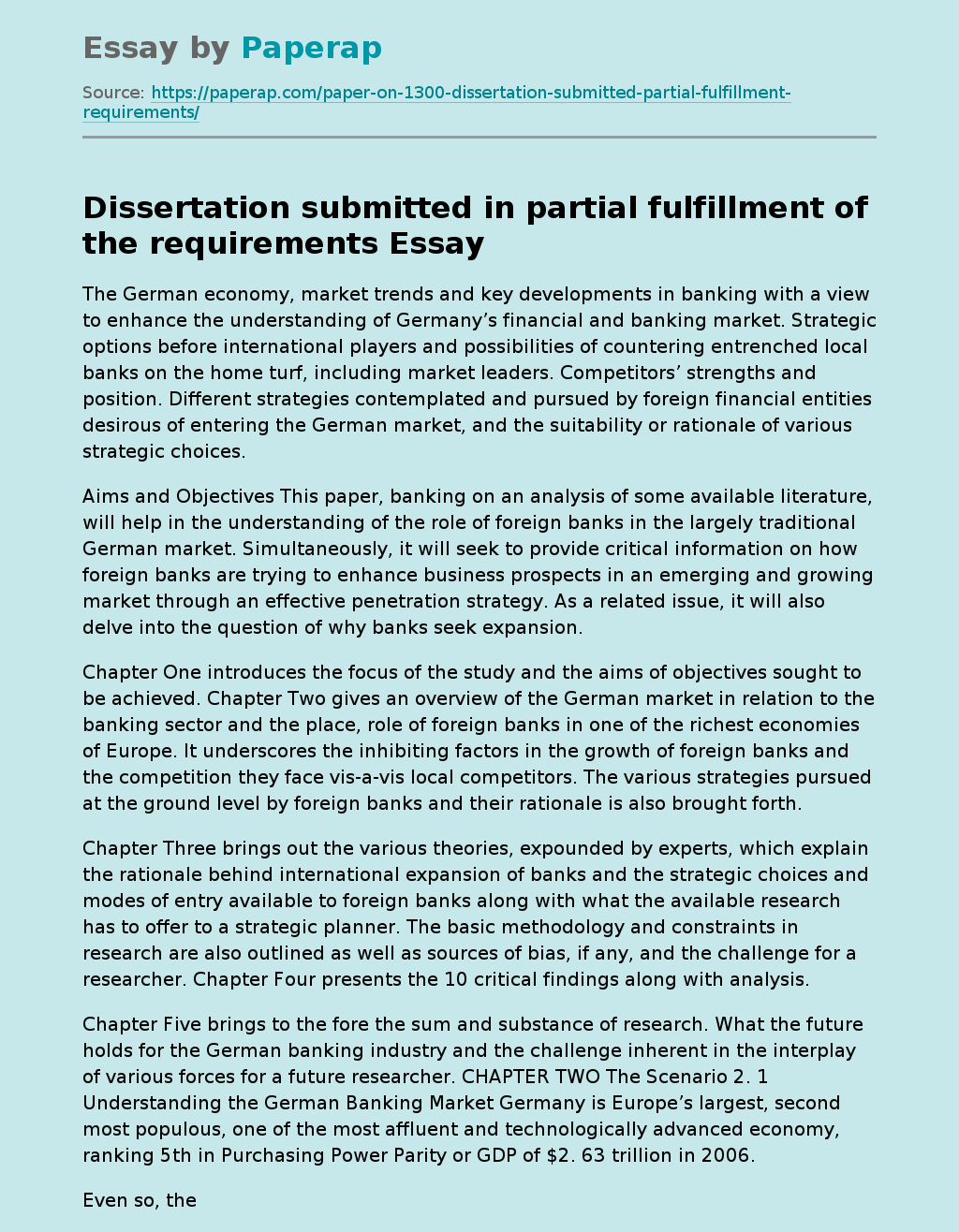German Economy, Market Trends and Key Events in Banking
The following sample essay covers the German economy, market trends and key events in the banking industry. To read the introduction, body, and conclusion of the essay, scroll down.
The German economy, market trends and key developments in banking with a view to enhance the understanding of Germany’s financial and banking market. Strategic options before international players and possibilities of countering entrenched local banks on the home turf, including market leaders. Competitors’ strengths and position. Different strategies contemplated and pursued by foreign financial entities desirous of entering the German market, and the suitability or rationale of various strategic choices.
Aims and Objectives This paper, banking on an analysis of some available literature, will help in the understanding of the role of foreign banks in the largely traditional German market. Simultaneously, it will seek to provide critical information on how foreign banks are trying to enhance business prospects in an emerging and growing market through an effective penetration strategy. As a related issue, it will also delve into the question of why banks seek expansion.
Chapter One introduces the focus of the study and the aims of objectives sought to be achieved. Chapter Two gives an overview of the German market in relation to the banking sector and the place, role of foreign banks in one of the richest economies of Europe. It underscores the inhibiting factors in the growth of foreign banks and the competition they face vis-a-vis local competitors. The various strategies pursued at the ground level by foreign banks and their rationale is also brought forth.
Chapter Three brings out the various theories, expounded by experts, which explain the rationale behind international expansion of banks and the strategic choices and modes of entry available to foreign banks along with what the available research has to offer to a strategic planner. The basic methodology and constraints in research are also outlined as well as sources of bias, if any, and the challenge for a researcher. Chapter Four presents the 10 critical findings along with analysis.
Chapter Five brings to the fore the sum and substance of research. What the future holds for the German banking industry and the challenge inherent in the interplay of various forces for a future researcher. CHAPTER TWO The Scenario 2. 1 Understanding the German Banking Market Germany is Europe’s largest, second most populous, one of the most affluent and technologically advanced economy, ranking 5th in Purchasing Power Parity or GDP of $2. 63 trillion in 2006.
Even so, the past decade has seen high unemployment rates because of macroeconomic stagnation, declining level of investment in plant and equipment, company restructuring, flat domestic consumption, structural rigidities in the labor market, lack of competition in the service sector, and high interest rates. Compared to an average of 0. 7% during 2001-2005, the growth rate has improved considerably to 2. 2 % in 2006 (CIA – The World Fact Book: https://www. cia. gov/library/publications/the-world-factbook/geos/gm. html).
The German banking sector, including central, provides jobs to about 700,000, approximately 1. 8% of the total employment. In terms of gross national product, the volume of business has grown three times as fast as the aggregate economic output since 1960. The share of total gross value added is currently 3. 2%. The dense branch network is the highest in the world with 2,400 banks, including almost 400 small banks, with a balance sheet of less than €100 million. German banking is structured into three primary legal groupings; private commercial, co-operative and public sector banks.
Unusual in a market economy, public sector banks hold a relatively large market share compared to other countries (The Association of German Banks, Berlin). The public sector still owns (Klaus-Peter Muller, President of the Association of German Banks and Chairman of the Board of Managing Directors of Commerzbank AG) owns over 40% of the German banking market. “It is possible for public-sector banks to acquire private ones- and indeed they do so. But by law- that is to say because of political decisions- this cannot happen the other way around.
German market undoubtedly remains too fragmented compared to its international counterparts. The five biggest banks in Germany have a combined market share of only 22% – the lowest in Europe. In countries such as Belgium, the Netherlands or Finland, by contrast, the five biggest financial institutions share over 80% of their domestic market. With an ROE of 13%, Germany still lags far behind other countries in the European Union. The average ROE before tax in the 25 “old” member states is 21% (Klaus-Peter Muller). ”
German Economy, Market Trends and Key Events in Banking. (2017, May 26). Retrieved from https://paperap.com/paper-on-1300-dissertation-submitted-partial-fulfillment-requirements/

